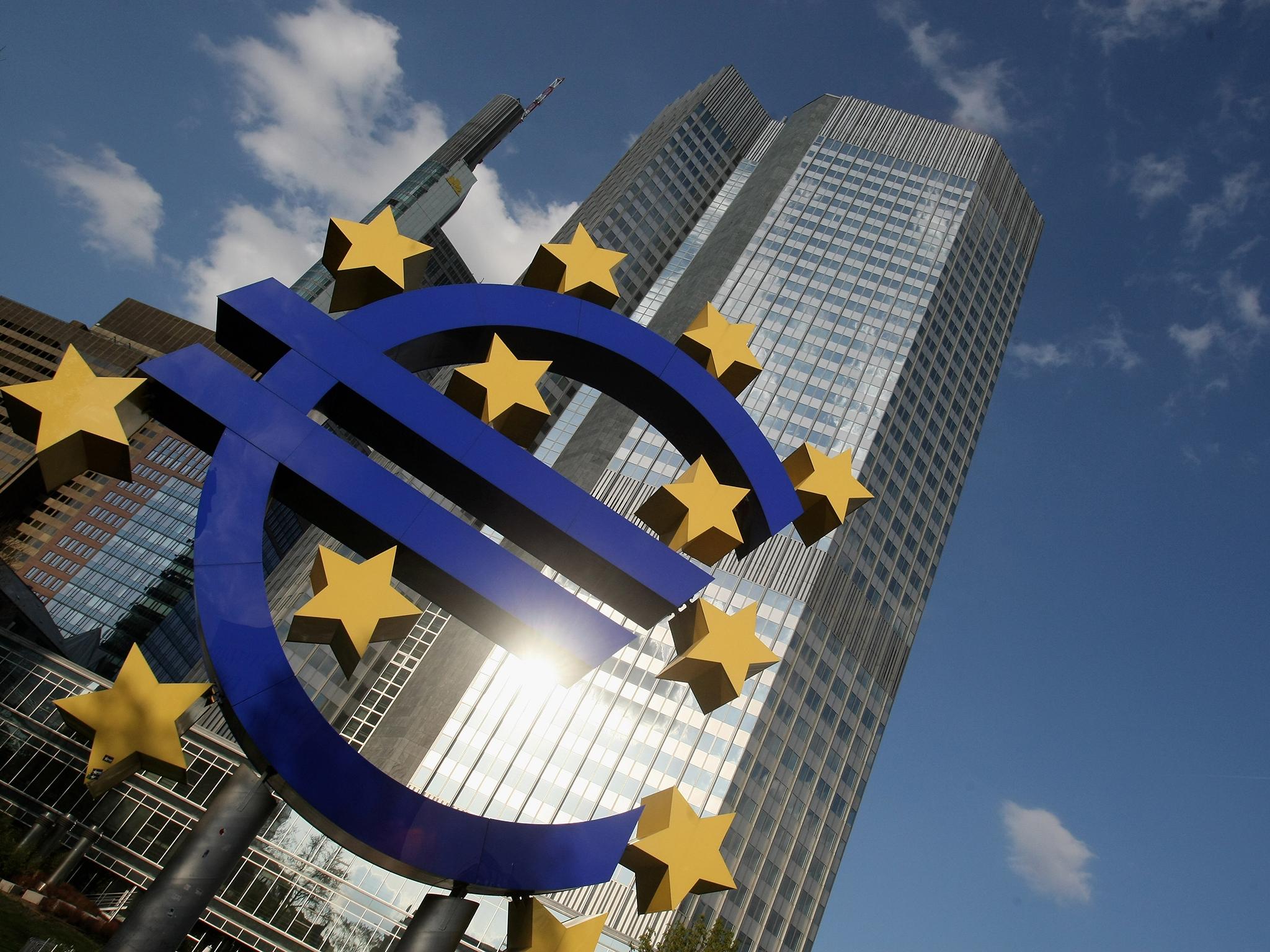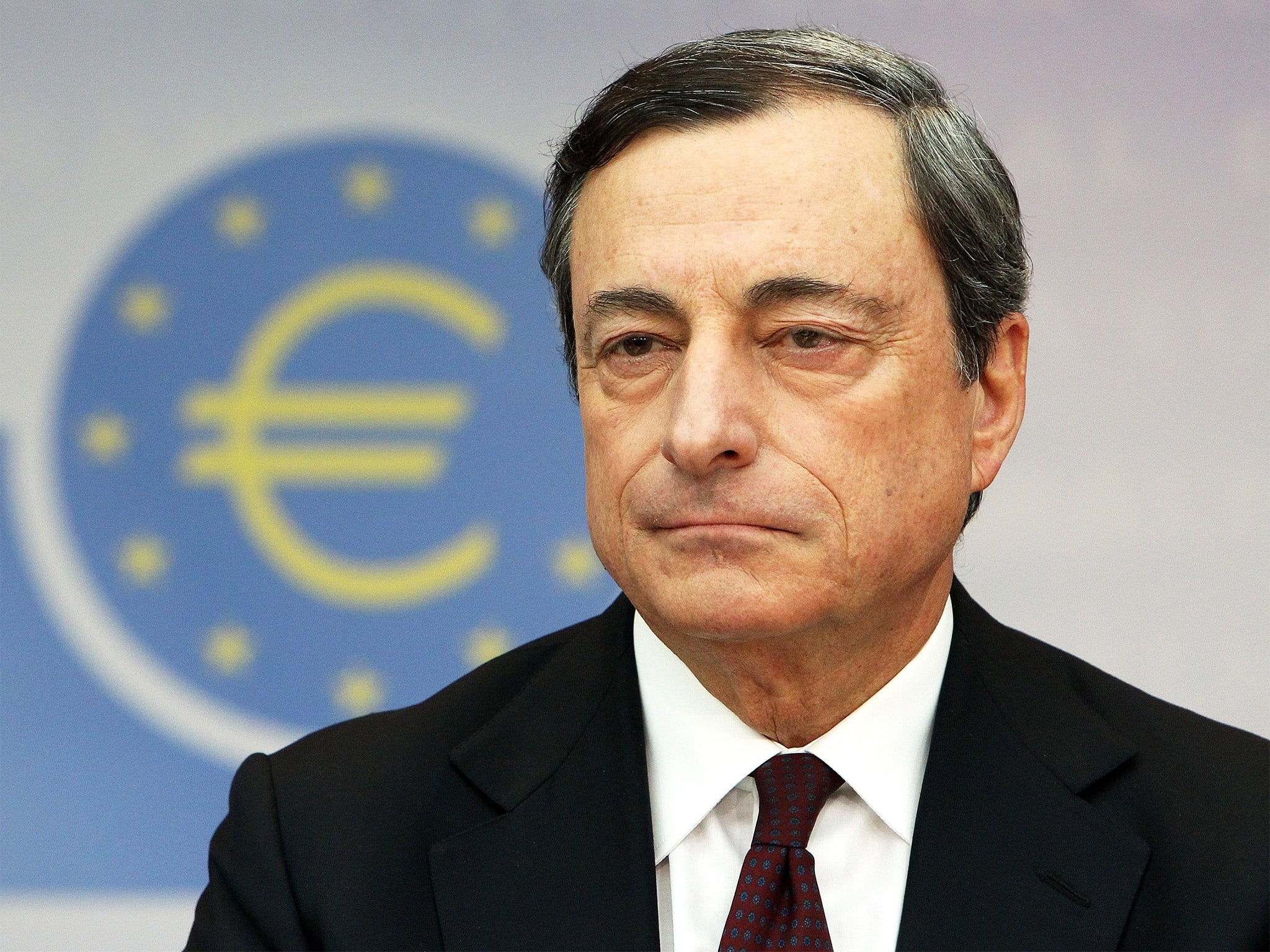European Bank to buy $1.1 trillion in bonds to try and avert economic stagnation in eurozone
Quantitative easing unveiled by Mario Draghi provides instant boost to shares

The European Central Bank launched a programme of emergency sovereign bond purchases today in an attempt to pull the eurozone out of the grip of deflation and economic stagnation.
The quantitative easing (QE) scheme unveiled by the European Central Bank’s president, Mario Draghi in Frankfurt, was larger than financial markets had been expecting, and instantly gave a boost to company share prices across the Continent.
The price of sovereign bonds of struggling eurozone states such as Spain and Italy also rose in response to the decision, reducing these countries’ effective borrowing costs. Meanwhile, the value of the euro sank against the dollar. The single currency was also down sharply against sterling, representing a boost for UK holidaymakers heading to the Continent.
Mr Draghi said the central bank would purchase €60bn of eurozone sovereign bonds and other safe financial assets, every month between March and September 2016, or until inflation is back to the central bank’s target.
That implies total purchases worth around €1.1trn, equal to around 10 per cent of the eurozone’s GDP.
In another comforting message to financial markets which had been concerned that some member states might seek to veto the monetary stimulus programme, Mr Draghi said there had been a “large majority” on the ECB’s governing council in favour of triggering the bond-buying programme now. “So large that we did not need to take a vote,” he said.
The ECB’s announcement came as the German Chancellor Angela Merkel was being interviewed on stage in Davos by the World Economic Forum’s founder Klaus Schwab. Delegates spilled into the atrium after the session ended to comment.
Stefan Löfven, Prime Minister of Sweden, which is not in the eurozone, welcomed the announcement.
“I think it is good, it is positive, yes, because we need an extra push,” he said. “It is always a question of when is the right time but, absolutely, this decision is positive.”
Lord Turner, the former chair of the Financial Services Authority, said the eurozone really needs extra government spending and debt write-offs but that the bond purchases should help to create growth. “Within the constraints of [eurozone] politics this is probably as good as we get and it will have a beneficial effect” he said.
City of London analysts were enthusiastic. “Once again, Draghi delivers” said Christian Schulz of Berenberg Bank. “Expectations have risen considerably in recent days, but the ECB still managed to beat most”.
However Jonathan Loynes of Capital Economics sounded a note of caution. “Even sizeable amounts of QE are unlikely to transform the outlook for the eurozone economy and eliminate the risk of a prolonged and damaging bout of deflation” he warned.
The amount of each nation’s sovereign bonds that will be purchased under the scheme will be determined by the relative size of their economies in the eurozone. In a message likely to be aimed at Greece’s voters ahead of Sunday’s election, Greece will, ultimately, be included in the scheme, but only as long as Athens doesn’t breach the terms of its 2010 eurozone bailout.

The radical Syriza, which is leading in the polls, is threatening to tear up the bailout agreement.
But in what was likely to have been a concession to Germany, which has deep misgivings about QE, the risk of the sovereign bonds defaulting will not be shared equally between the 19 members of the eurozone.
Mr Draghi revealed that 20 per cent of the risk would be collectively held, leaving 80 per cent on the books of national central banks and, as a consequence, their own governments. In a further safeguard to appease sceptics Mr Draghi said the ECB would not buy more than 33 per cent of any single country’s outstanding debt.
The purpose of the programme, which is similar to the QE programmes that the US central bank and the Bank of England put in place back in 2009, is to push consumer price inflation in the single currency back up to the ECB’s official 2 per cent target.
Prices dipped by 0.2 per cent in December, putting the eurozone in deflation for the first time since the global financial crisis. The eurozone’s GDP has also barely grown since 2008.
The eurozone came close to a break-up in 2012 when the borrowing costs of Spain and Italy soared as investors sold their debt. The panic abated when Mr Draghi said in a speech in London that he would do “whatever it takes” to keep the single currency together, and unveiled a separate plan to buy the bonds of solvent states that were being frozen out by the financial markets.
The ECB’s QE programme – at 10 per cent of GDP – will still be smaller than those implemented in other advanced countries in recent years. The Bank of England has acquired government bonds worth 20 per cent of GDP. America’s Federal Reserve has acquired assets worth 25 per cent, while the Bank of Japan’s bond-buying programme is worth more than 60 per cent of the Asian country’s GDP.
Join our commenting forum
Join thought-provoking conversations, follow other Independent readers and see their replies
Comments
Bookmark popover
Removed from bookmarks